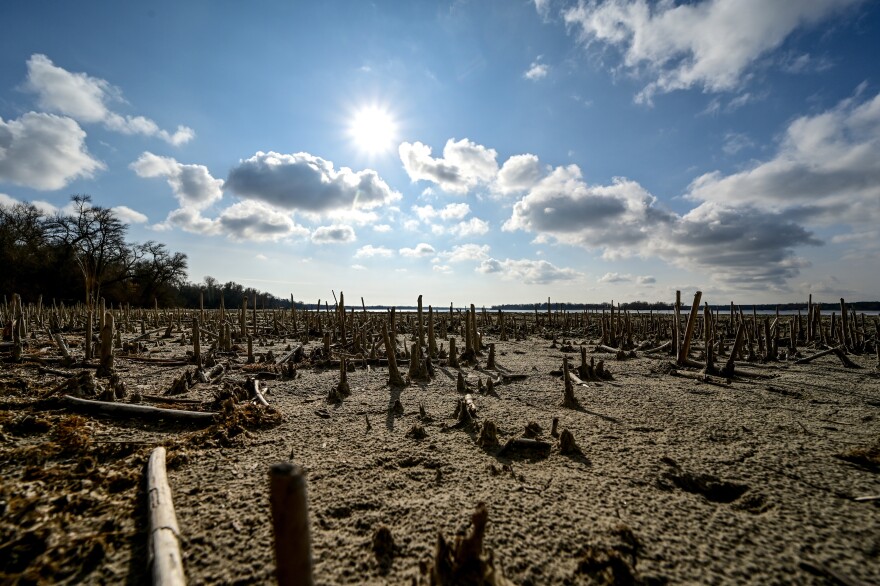At the massive Kakhovka Reservoir in southern Ukraine, water levels should be rapidly rising. As winter snowmelt and rain flow into the Dnipro River, the reservoir fills so it can be used later in the year by farmers in the region's hot, dry summer.
But this spring, water levels at Kakhovka remain far below normal. The cause is a Russian-controlled hydroelectric power plant at the lower end of the reservoir. Since November, sluice gates at the plant have been left open, and water levels at Kakhovka have plunged to lows not seen in decades.
The reservoir is critical to southern Ukraine. It supplies water for villages and towns in the region and irrigates around half-a-million acres of farmland that's used to grow grains and vegetables. The Zaporizhzhia nuclear power plant also relies on it for cooling water.
Loading...
The Ukrainian government has tried to stem the flow by releasing water from other Ukrainian-controlled reservoirs along the Dnipro River to refill Kakhovka, but it's at best a temporary solution.
Experts say that the situation at the reservoir highlights the growing impact of Russia's war on Ukraine's water supply.
"The attacks on electricity systems have been very explicitly covered, because they've been relentless," says Peter Gleick, a senior fellow at the Pacific Institute in Oakland, Calif. "But there have also been intentional attacks on water treatment systems and wastewater service systems, and that has cut off safe water for literally millions of Ukrainians."
In a paper out earlier this month, Gleick and his co-authors chart dozens of ways the war has impacted water throughout the country. Wastewater facilities have lost power, fouling their treatment pools, pumping stations have been bombed, cutting off towns from fresh water, and dams demolished, flooding nearby homes.

In the southern city of Mykolaiv, residents lost water last year after fighting severed a crucial pipeline. The water system had to be connected to a brackish source that, while giving people access to water for washing clothes and bathing, has led to further problems, according to Oleksandra Shumilova, a researcher at the Leibniz Institute for Freshwater Ecology and Inland Fisheries in Berlin, Germany. "Because of this salty water, the water supply system was damaged by corrosion," she says.
Earlier this year, the United Nations stated that the war had devastated Ukraine's water system. It estimates roughly 16 million people in Ukraine needed water, sanitation and hygiene assistance in 2022. Gleick says he believes that since his team's study was conducted in the early days of the war, which began in late February of 2022, other parts of Ukraine's water supply have been damaged in the war. "We know there have been many, many additional attacks on water infrastructure," he says.
Loading...
And the ongoing problems at Kakhovka are a high-profile reminder that the war's impact on Ukraine's water supply is far from over. At the Kakhovka hydroelectric power plant, some of the dam's sluice gates have been damaged in explosions and attacks, while others appear to be deliberately left open, allowing a torrent of water to drain from the reservoir. After dropping to just 46 feet (14 meters), the reservoir's water level has begun rising again, because the Ukrainian government is filling it with water from other reservoirs on the Dnipro River, where the Kakhovka Reservoir is located. But to fill Kakhovka, the government warns, it is necessarily taking water from elsewhere in Ukraine.
"All of this poses a threat of lowering the water level to a critical level throughout the whole cascade of Dnipro reservoirs in Ukraine," Ukraine's Ministry of Environmental Protection and Natural Resources told NPR in a statement. "As a result, 70% of the population of Ukraine, who consume water from Dnipro, may be deprived of water."
As the year wears on, things are likely to get even worse. The lowered water levels at Kakhovka have exposed a lot of vegetation along the shore line, Shumilova says. That in turn could lead to eutrophication, the growth of algae and other contaminants, which would further degrade water quality in the reservoir.
According to Shumilova, the Kakhovka reservoir normally supplies irrigation water to a nearly 1,000 mile system of channels that supply fields of fresh vegetables, wheat and millet. That agricultural production is likely to be in peril, as is drinking water for hundreds of thousands of residents. "In my opinion, the summer months will be quite tough," she says.
Copyright 2023 NPR. To see more, visit https://www.npr.org.




